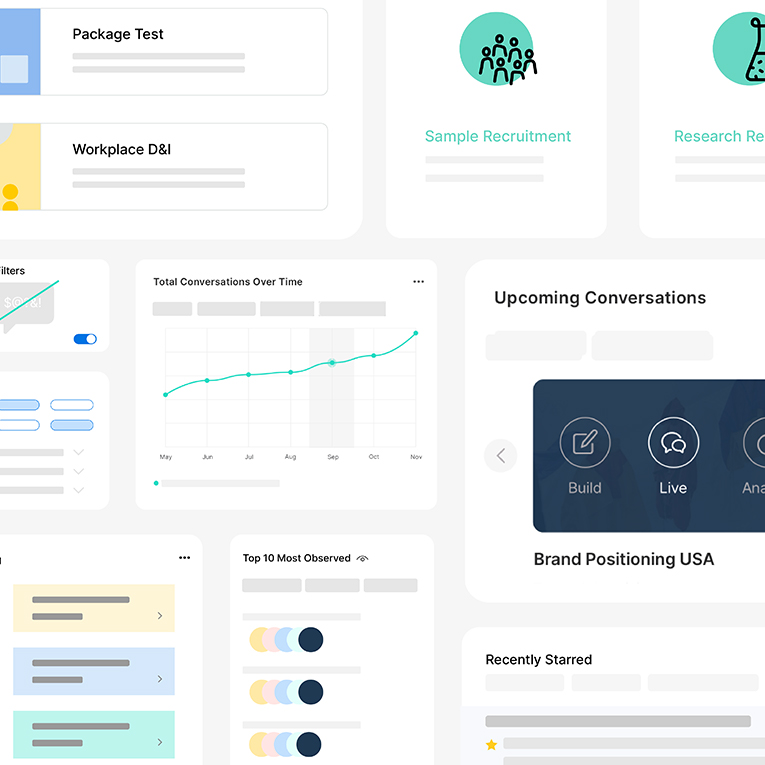.webp)
Trends
How to Calculate Your Sample Size Using a Sample Size Formula

.png)

.png)
Read More

.png)
.png)
.png)
Maria Noesi
November 25, 2021
.webp)
.webp)
.webp)
.webp)
.webp)
Analyzing Research Data: A Guide to AI-Powered Efficiency
Analyze research data with the right software. Learn how to import, interpret, and report on survey responses and any open-ended data.

Modern research professionals are tasked with navigating a sea of data, under pressure to extract insights faster than ever. Whether it involves sifting through thousands of survey responses or meticulously analyzing hours of interview footage, researchers are on a quest for efficiency. This is especially true for qualitative data. While open-ended responses can provide the powerful “why” to your quantitative study, analyzing qualitative data can be a non-starter. The solution lies in utilizing the right software for analyzing research data.
AI-powered research technology that is specifically designed for qualitative, agile research and quick-turn research, can transform the way we handle interview transcripts, qualitative research, and open-ended responses.
In this article, I’ll overview how researchers can start analyzing research data using AI-powered software, including summarizing, clustering, and coding survey responses. By converting complex datasets into clear insights quickly, researchers can optimize their workflow significantly.

Here's how software can be used during each phase of research:
Collecting & Importing Data
Selecting the right method for collecting survey responses is crucial and depends on the study’s specific goals, constraints, and available resources. For analyzing open-ended research, Remesh emerges as a leading AI insights tool, facilitating both instantaneous live data collection and traditional asynchronous survey methods.
But even if the researcher elects to use a different data collection method, they can still use Remesh’s powerful analysis suite by importing their data into the platform. Researchers can import survey data or any structured open-ended data, and merge datasets together. This empowers researchers to seamlessly integrate survey responses, observational data, or experimental results into their studies.
Here’s how to upload data for analysis
There are two primary ways to bring data into Remesh for analysis. The first is to download data from a survey platform like Qualtrics and import it, which is a near-immediate upload, even for larger data sets of up to 10,000 participants. The platform does all the mapping on the backend to make this a seamless process.
The other way is to upload any open-ended comments into a template provided by Remesh. The template has the survey questions as columns and respondents as rows. Researchers populate the template with the open-ended responses and upload them into the platform. The data is automatically analyzed, summarizing key themes, tagging concepts, coding the responses, etc. This allows users to quickly make sense of open-ended survey feedback at scale.
The data import feature is designed for structured data, including surveys and structured interviews. For unstructured interview transcripts, some initial data cleanup may be required to divide participant responses by question. Some text length restrictions also exist, with open-ended responses capped at 500 characters.

Interpreting Findings
Analyzing research data is a critical step in the research process, and Remesh’s technology aids researchers in uncovering hidden patterns and correlations, making it an invaluable tool for analyzing surveys, structured interviews and qualitative research in general. This efficiency not only saves precious hours but also enhances the depth of analysis, allowing for more insights to emerge.
Specific software features to analyze research data
Thematic Clusters: The Remesh proprietary algorithm maps all responses in 3D space, grouping responses that are semantically similar closest together and those that are semantically dissimilar farthest apart. The user selects how many total groups they want to view the responses in, and then the system creates the best groupings, or clusters. The researcher can adjust how many total groups to show until they get the best picture of their data. Data with a lot of variation in responses will benefit from more groups, whereas data with less variation will benefit from fewer groups.

Summarize: Remesh leverages large language models to summarize the dataset using a sampling of the responses. Researchers select from several sampling options and can add their segmentation file to the response data set in order to see summarization by different participant demographics and behavioral attributes. The programmatic summarization tool helps validate the researcher's understanding and refine the narratives derived from the data.
Auto-Code: Manually coding survey responses is time-consuming and costly, and many software solutions for coding require too much upfront effort to be worth it. However, the proprietary algorithm, working in combination with large language models, can surface the right amount of nuance and context with system-generated categories and codes. Researchers can tailor the system-generated codes, merging tags or modifying categories to best represent the data according to their insights and additional context. This human-in-the-loop approach makes coding fast without losing the discretion that is so important when analyzing research data.
For even more detail on how auto-code works, read my article on Greenbook: AI is Transforming Qualitative Research Coding
Reporting research insights
Remesh’s reporting capabilities are designed for quick-turn research. Visual elements like word clouds, theme visualizations, and sentiment analysis charts are invaluable in research reporting. They provide a fast and intuitive understanding of the data's key points. AI-powered tools automate the creation of these visuals, ensuring that they are both informative and engaging. Incorporating these visuals into your report can significantly enhance its readability and impact.
One of the standout features of AI analysis tools is their ability to create programmatic summaries of the collected data. These summaries can serve as a draft of your report's executive summary. This saves time and serves as a gut-check for researchers.
While AI tools provide a solid foundation for your report, customization is key to addressing the specific needs of your audience. Use the AI-generated summaries and visuals as a starting point, and then tailor your report to highlight the insights most relevant to your stakeholders. This might include adding contextual analysis, recommendations, or exploring the implications of the findings in greater detail.
Read next: The future of AI in policymaking
Conclusion: Analyzing Research Data with the Help of AI
The integration of AI into research practices is not about replacing traditional methodologies but augmenting them. By enhancing data collection, interpretation, and reporting processes, AI research technology like Remesh empowers researchers to navigate the complexities of analyzing qualitative research and open-ended data with unprecedented speed and agility. Embrace AI-powered tools to unlock the full potential of your research, leading to insightful "Ah-ha" moments that make research findings a catalyst for informed decision-making and organizational advancement.
More

Remesh Evolution: AI-Powered Insights Platform Unveils Major Updates to Satisfy Market Demand for High-Quality, Human-Centric Research

.png)

.png)
Read More

.png)
.png)
.png)

.png)

.png)
Learn More

.png)
.png)
.png)


Stay up-to date.
Stay ahead of the curve. Get it all. Or get what suits you. Our 101 material is great if you’re used to working with an agency. Are you a seasoned pro? Sign up to receive just our advanced materials.



